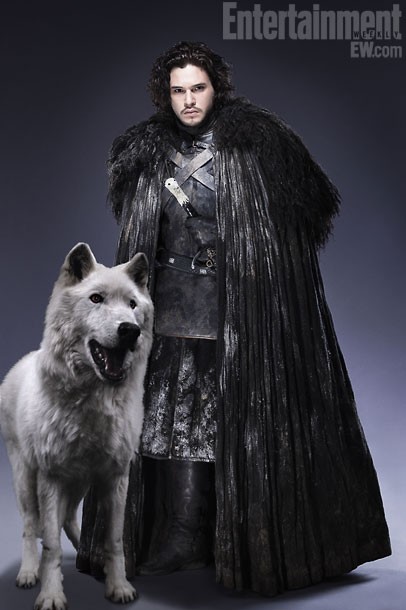The critically acclaimed drama series, Game of Thrones, captivated audiences worldwide with its intricate plot, mythical creatures, and, of course, the majestic dire wolves. These loyal and fierce animals became iconic, sparking a wave of fascination and perhaps, a desire to own one. As pet experts at pets.edu.vn, we understand the allure of these creatures, but it’s crucial to separate fantasy from reality. If you’re wondering, “Can You Have A Dire Wolf As A Pet?”, let’s delve into the facts.
The Dire Wolf: A Creature of the Past
For those enchanted by the dire wolves of Game of Thrones, the first thing to understand is their existence in reality. Dire wolves were not just a figment of George R.R. Martin’s imagination; they were real animals that roamed the Earth. However, these magnificent canids have been extinct for approximately 10,000 years.
Imagine a wolf significantly larger and more powerful than the gray wolves we know today. Dire wolves were imposing creatures, measuring around five feet in length and weighing up to 175 pounds. Their bite force was estimated to be 129% stronger than that of a modern gray wolf, and they were about 25% larger overall. While similar in shape to gray wolves, these were truly giants of their time. So, when considering “can you have a dire wolf as a pet,” the answer, based on their extinction alone, is a definitive no. You simply cannot have a dire wolf as a pet because they no longer exist.
Seeking the Dire Wolf Look-Alike: Breeds to Consider
While owning a genuine dire wolf remains in the realm of fantasy, the desire for a dog with a similar imposing appearance and wolf-like traits is understandable. Fortunately, several dog breeds capture the essence of the dire wolf in looks, though not in extinct species status. If you’re drawn to the dire wolf aesthetic, here are a few breeds that might pique your interest:
The Northern Inuit Dog
The Northern Inuit breed has gained considerable attention, particularly due to its resemblance to the dire wolves in Game of Thrones – they were, in fact, used in the show to portray young dire wolves. This breed was developed in the UK in the late 1980s to create a wolf-like dog suitable for domestic life.
Northern Inuits are known for their striking wolf-like appearance, with a thick double coat, piercing eyes, and a sturdy build. While they possess a friendly and gentle temperament, rarely displaying aggression, potential owners should be aware of their specific needs. These dogs are intelligent and independent, which can translate to stubbornness, making training a challenge for novice owners. They require significant space, substantial daily exercise, and thrive on strong family bonds. The popularity surge, partly fueled by Game of Thrones, has led to long waiting lists and high prices, but more importantly, it’s crucial to consider if you can truly provide the demanding environment these dogs need before bringing one home. They are not ideal for apartment living or owners with limited time and experience.
The National American Alsatian
For those truly captivated by the wolf-like appearance combined with a more domestic temperament, the National American Alsatian is another breed to explore. Developed in the forests of Oregon starting in 1987, this breed is still relatively new and not yet officially recognized by major kennel clubs, but gaining traction.
The American Alsatian was specifically bred to resemble the now-extinct dire wolf in appearance, while prioritizing a gentle and trainable temperament. This breed is a mix of Alaskan Malamute, German Shepherd, Great Pyrenees, Anatolian Shepherd, and English Mastiff. This combination results in a large, powerful dog with a wolfish look, but bred for companionship and a calmer disposition than some other wolf-like breeds. They are intended to be family-friendly and less demanding than some of the more high-energy breeds.
Wolf Hybrids: Proceed with Extreme Caution
Wolf hybrids, crosses between wolves and domestic dogs, are another category that sometimes attracts those seeking a “dire wolf” pet. However, as pet experts, we strongly advise against considering wolf hybrids as pets for the average person.
While they may possess a striking wolf-like appearance, wolf hybrids come with significant challenges and ethical considerations. Their behavior can be unpredictable, combining wild instincts with domestic traits. They require specialized care, extensive secure enclosures (think reinforced fencing and dig-proof yards), and experienced handling. Dealing with breed-specific biases and managing the complex psychology of an animal that is part wild can be overwhelming. Wolf hybrids are not suitable for typical pet homes and demand a lifetime commitment and understanding that goes far beyond standard dog ownership. Unless you have decades of experience with wolves or wolf hybrids, and a truly exceptional living situation, they are not pets to be considered.
Beyond the Fantasy: Responsible Pet Adoption
The allure of a dire wolf is undeniable, fueled by popular culture and the inherent mystique of wolves. However, when considering “can you have a dire wolf as a pet,” remember the reality: dire wolves are extinct. Focusing on breeds that resemble them should be approached responsibly and with careful consideration of their specific needs.
Instead of solely chasing a specific look inspired by fantasy, consider the millions of wonderful animals in shelters and rescues waiting for loving homes. Many dogs, including those with wolf-like appearances, are in need of companionship and care. Adopting a dog should be about providing a home for a deserving animal and welcoming a friend and family member into your life, not solely about replicating a fictional creature. If your primary motivation for getting a dog is because “dire wolves in Game of Thrones are really pretty,” it’s time to reconsider your reasons and ensure you’re ready for the true commitment of pet ownership, based on companionship and care, not fantasy fulfillment.

